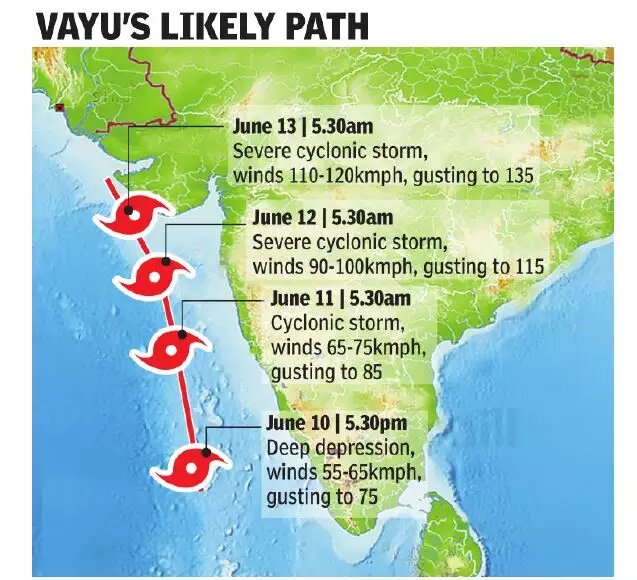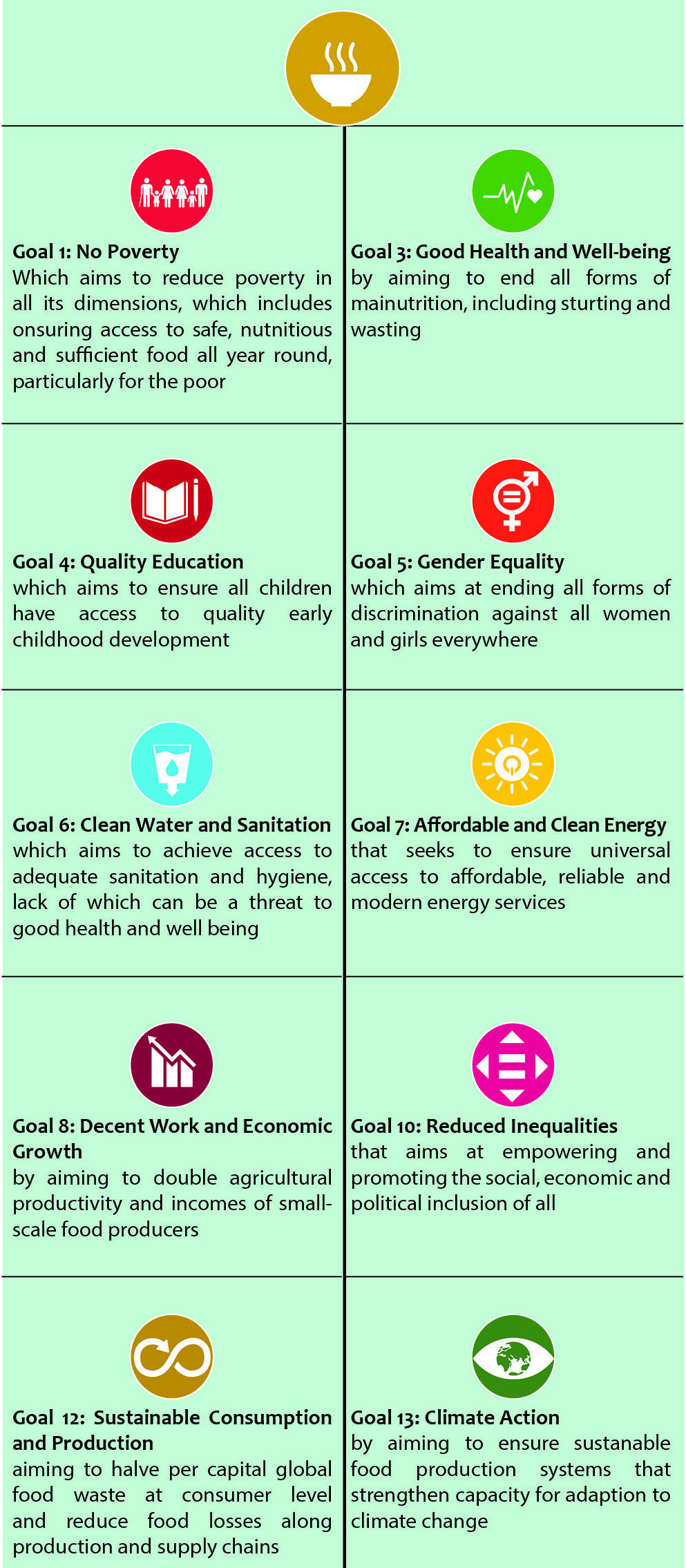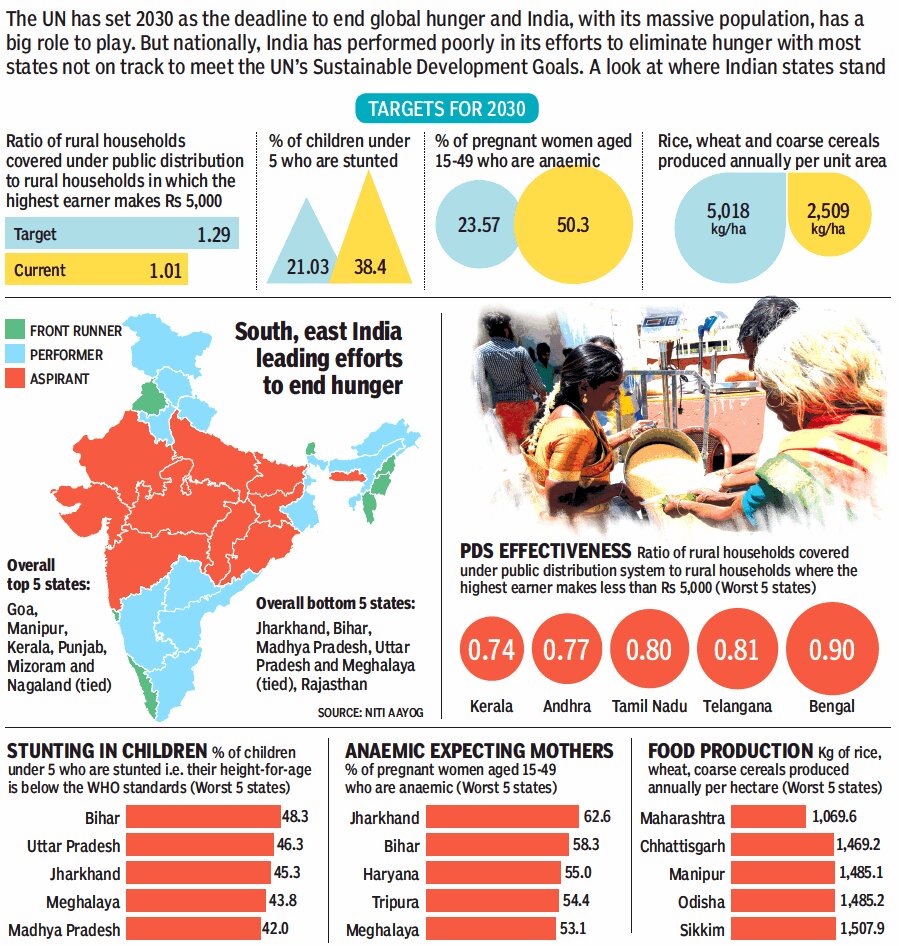India and the Hunger Fight
The United Nations has set the year 2030 as the deadline to end global hunger and India as of now has performed poorly in its efforts to eliminate hunger with most states not on track to meet the UN’s Sustainable Development Goal-2 (SDG-2).
Sustainable Development Goal-2 (Zero Hunger)
- Goal 2 seeks sustainable solutions to end hunger in all its forms by 2030 and to achieve food security.
- The aim is to ensure that everyone everywhere has enough good-quality food to lead a healthy life.
- Achieving this Goal requires better access to food and the widespread promotion of sustainable agriculture. This entails improving the productivity and incomes of small-scale farmers by promoting equal access to land, technology and markets, sustainable food production systems and resilient agricultural practices.
Goal-2 is closely related with other goals as below
India’s Performance (NITI Aayog Baseline Report, 2018)
Government of India Initiatives
- The National Nutrition Strategy aims to accelerate the decline of malnutrition in India. The National Nutrition Mission monitors growth of children, as well as checks the pilferage of food rations provided at Anganwadi Centres.
- POSHAN Abhiyaan, launched in 2017-18, aims to reduce stunting, under-nutrition, anemia and low birth weight babies through synergy and convergence among different programmes, better monitoring and improved community mobilisation.
- Antoydaya Anna Yojana (AAY) aims to provide food at subsidized prices to poor families.
- The Integrated Child Development Scheme (ICDS) envisages comprehensive early childhood care and development by focussing on children in the age group of 0-6 years, pregnant women and adolescent girls.
- Mid-day Meal (MDM) scheme aims to improve nutritional levels among school children which also has a direct and positive impact on enrolment, retention and attendance in schools.
- Under the Pradhan Mantri Matru Vandana Yojana (PMMVY), Rs.6,000 is transferred directly to the bank accounts of pregnant women for availing better facilities for their delivery.
- The National Mission on Agriculture Extension and Technology enables delivery of appropriate technologies and improved agronomic practices for farmers.
- The National Mission on Sustainable Agriculture and the National Food Security Mission aims to enhance agricultural productivity, and the Pradhan Mantri Krishi Sinchayee Yojana (PMKSY) aims to improve water-use efficiency.
Administration of Agriculture Sector
Agricultural distress in the country and the inability of the State to deal with the problem is raising the demand of shifting agriculture from State list to the Concurrent list.
Constitutional provisions
- Entry 14 of State list of Schedule VII of the constitution mentions agriculture as a state subject.
- Agriculture, including agricultural education and research; protection against pests and prevention of plant diseases.
- Government of India Act, 1935 has provided to keep agriculture in the hands of the states.
- The logic then was that since agriculture was basically region-specific and depended primarily on local agro-ecological conditions and native natural resources, the provincial administrations would be better placed to look after it.
- The predominantly subsistence type of agriculture in vogue in those days was, more or less, self-contained with little inter-regional interactions for procuring inputs or selling the output. The problems besetting the farmers, too, were generally location-specific.
Modern-day challenges
- Integrated economy: The modern agriculture transgresses regional boundaries with inter-state commercial dealings being part of the game. Agriculture is also getting integrated with other sectors of the economy, notably trade, industry and services.
- Policy initiatives and regulatory decisions are taken by one state can now affect, directly or tacitly, the agri-economy of the other states as well.
- Dependence on states: At present, the Centre has to rely on the state governments to implement even those farm development and farmer’s welfare schemes that are sponsored and funded by it.
- The decisions concerning support prices of crops, institutional credit and agri-commodities trade, both domestic and international, are taken by the Centre
- Important legislation: having a significant bearing on agriculture have been enacted by Parliament and are being administered by the Centre.
- The Protection of Plant Varieties and Farmers’ Rights Act.
- The Biological Diversity Act.
- The National Food Security law.
- In-effective initiatives: to address the farmer’s problems and to boost their incomes are not delivering the expected results because of non-cooperation of some state governments.
- The notable ones among these are the crop insurance scheme; the Pradhan Mantri Kisan Samman Nidhi (PM-Kisan) and Pradhan Mantri Annadata Aayy Sanrakshan Abhiyan (PM-AASHA) to ensure remunerative prices for the farm produce.
- Some vital reforms concerning agricultural marketing, land leasing, contract farming and a few others are not making much headway for the same reason.
- An unbridled control of the states over the farm sector is, therefore, posing problems and proving counterproductive.
Advantages
- Joint responsibility: The bulk of the funding for rural infrastructure, irrigation and other farm development programmes comes from the Centre.
By placing agriculture in the Concurrent List, serving farmers and saving farming becomes a joint responsibility of the Centre and the states.
Recommendations
- M.S. Swaminathan-headed National Commission on Farmers in his fifth and final report submitted in October 2006 has recommended shifting agriculture from the State List to the Concurrent List of the Constitution.
- This would allow the Union government to have a greater and a relatively more decisive say in the matters related to agriculture and farmers without majorly diluting the powers of the state governments.
- The Dalwai committee: on the issue of doubling farmer's income, has also pitched for placing farm marketing in the Concurrent List to enable the Centre to revamp agricultural mandi’s, improve their functional efficiency and expand the rural marketing infrastructure.
- In the past, the Constitution has been altered to switch items from one List to another.
- The 42nd amendment, carried out in 1976, had shifted five subjects, including forests and wildlife protection, from the State List to the Concurrent list.
- Looking at the significance of the issue and the potential gains from it, all political parties should support another Constitution amendment to put agriculture in the Concurrent List for the benefit of the farmers.
Cyclone Vayu
The India Meteorological Department issued an orange alert over Cyclone Vayu.
- Cyclone Vayu, named by India, is only a deep depression and is still to develop into a strong cyclone.

- The cyclone is currently positioned around 250 km northwest of Amindivi island in Lakshadweep and about 750 km southwest of Mumbai in the Arabian sea.
- Cyclone Vayu is moving towards the North (expected to hit Gujarat coast) and is expected to draw moisture away from the monsoon that in turn will delay the arrival of monsoon
- The cyclone is expected to interfere with normal progression, by sucking all the moisture from the monsoon winds towards itself.
- Cyclones are sustained by very strong low-pressure areas at their core. Winds in surrounding areas are forced to rush towards these low-pressure areas.
- Similar low-pressure areas, when they develop near or over land, are instrumental in pulling the monsoon winds over the country as well.
- But right now, the low-pressure area at the center of the cyclone is far more powerful than any local system that can pull the monsoon winds moving northeast.
Different Cyclonic Alerts
- Yellow: Be Updated
- Orange: Be prepared
- Red: Take action
- Green: No warning
Arabian Sea Cyclones
- Cyclonic activity is comparatively less intense in the Arabian sea, as compared to the Bay of Bengal, where high-intensity severe cyclones originate frequently.
- In the last 120 years, just about 14% of all cyclonic storms, and 23% of severe cyclones, around India have occurred in the Arabian Sea.
- Arabian Sea cyclones are also relatively weak compared to those emerging in the Bay of Bengal.
- Gujarat coastline, where most of the cyclones emerging in the Arabian Sea are headed, is not very densely populated, ensures that the damage potential of the cyclones on the western coast is comparatively low.
Why is the Bay of Bengal More Prone to Cyclones?
- Temperature difference: The low-pressure system of cyclone need a continuous supply of heat energy and as the Bay of Bengal is warmer than the Arabian sea, it is able to provide the heat energy needed to sustain the low-pressure system.
- Sea surface temperatures and humidity: both directly correlate with chances of cyclone formation.
- The Bay of Bengal receives higher rainfall and constant inflow of fresh water from the Ganga and Brahmaputra rivers.
- This means that the Bay’s surface water keeps getting refreshed, making it impossible for the warm water to mix with the cooler water below, making it ideal for depression.
- On the other hand, the Arabian Sea receives stronger winds that help dissipate the heat, and the lack of constant fresh water supply helps the warm water mix with the cool water, reducing the temperature.
- Absence of large landmass between the Pacific and the Bay, allows cyclonic winds to easily move into the Bay of Bengal.
- Cyclones from Pacific ocean: low-pressure system originating from the Pacific ocean also travel towards the left to the Bay of Bengal.
Mount Sinabung
- Mount Sinabung, which has seen a spike in activity since 2010, erupted for around nine minutes on 9th June, 2019 , sending clouds of volcanic ash 7 km into the sky.
- Mount Sinabung, which is 2,460 m high, is among Indonesia's most active volcanoes, but had been inactive for four centuries before its 2010 eruption.
- Indonesia has nearly 130 active volcanoes, more than any other country. It is particularly prone to seismic activity due to its location on the “Ring of Fire,”an arc of volcanoes and fault lines encircling the Pacific Basin.
Bharat Stage - VI
International Centre for Automotive Technology (ICAT) released India’s first Type Approval Certificate (TAC) for Bharat Stage - VI (BS – VI) norms for the two-wheeler segment.
- Bharat stage norms are the emission norms which the automotive manufacturers have to comply to sell their vehicles in India.
- These norms are applicable to all two wheelers, three wheelers, four wheelers, and construction equipment vehicles.
- To curb the growing menace of air pollution through the vehicle's emission, the Government of India has decided to leapfrog from the existing BS – IV norms to the BS- VI, thereby skipping the BS – V norms, and to implement the BS – VI norms with effect from 1st April 2020.
- From 1st April 2020, only those vehicles will be sold and registered in India which complies with these norms.
- The norms are stringent and at par with global standards.
International Centre for Automotive Technology (ICAT)
- ICAT is the premier testing and certification agency authorized by the Ministry of Road Transport and Highways for providing testing and certification services to the vehicle and component manufacturers in India and abroad.
- It has the latest equipment, facilities, and capabilities to develop, validate, test and certify the engines and vehicles for the latest norms in the field of emission and many other facilities like crash lab, NVH lab, EMC lab and test tracks.
Valasa Devarlu
- Valasa Devarlu is an age-old rural festival, celebrated in the number of villages of Chittoor district of Andhra Pradesh.
- It is a traditional ritual, dating back to the reign of emperor Srikrishna Devarayalu or Krishna devaraya.
- It is celebrated in the face of drought conditions. When only a few weeks left for the sowing season to close.
- During the failure of rains, crops failure and breakout of epidemics, the entire population of a village would abandon the households at dawn and retreat into the fields or tank bunds till dusk.
- The village elders would initiate special pujas to the goddess ‘Valasa Devaramma’, an idol made of clay, consecrated under a tent or a tree. After having community lunch, the population would return to their village. The time is marked by dancing, singing and chit-chatting.
- The male members of the families offered prayers at the famous Gangamma temple atop Boyakonda hillock nearby, followed by animal sacrifice.
Krishna devaraya
- He was a prominent ruler of the Vijayanagara Empire of South India. As the third ruler of the Tuluva Dynasty of the Vijayanagara Empire, he extended the empire to most of South India, which included present-day Karnataka, Northern Tamil Nadu and Andhra Pradesh, stretching upwards in the northeast to Cuttack.
- He ascended the throne during the most critical stage of the empire and went on to consolidate it as a flourishing empire. He played a major role in defeating the Bahmani Sultans and Portuguese, forcing them to retreat their plans of expanding their empire beyond their boundaries.
Girish Karnad
Girish Raghunath Karnad noted actor, filmmaker and screenplay writer recently passed away at the age of 81.
- Girish Karnad was born (May 19, 1938) in Mumbai, Maharashtra.
- He was a director, actor and screenplay writer for many Kannada movies such as Samskara, Vamsha Vriksha, Kadu, Kanooru Heggadithi.
- He was the recipient of Padma Bhushan, Padma Shri, and Jnanpith Award, for his contributions towards the arts, literature, and theater.
- Yayati, Tughlaq, The Dreams of Tipu Sultan, Hayavadana were some of his famous plays.
- He also worked in Hindi cinema, directing the critically acclaimed Utsav (1984), an adaptation of Shūdraka’s 4th-century Sanskrit play Mrichchhakatika.
- He had also served as the Director of the Film and Television Institute of India and Chairman of the Central Sangeet Natak Academy.


